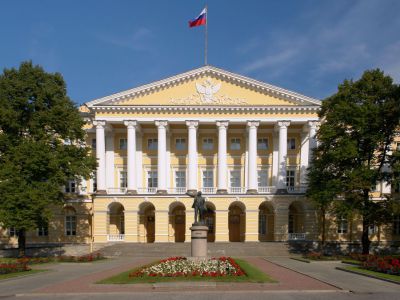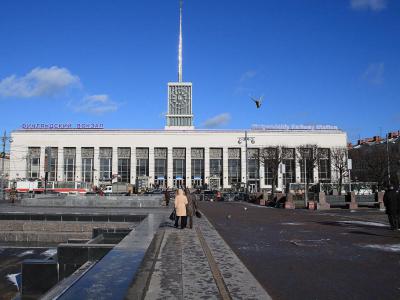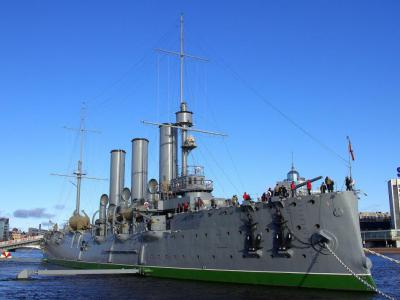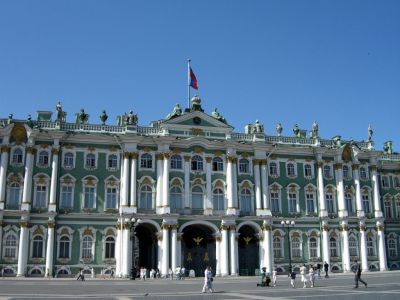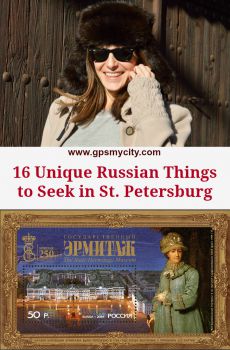Bolshevik Revolution Walking Tour (Self Guided), St. Petersburg
When thinking of the events that changed the course of history in the 20th century, one of the first places that comes to mind is St. Petersburg. The “cradle of three revolutions” waged against the Tsarist autocracy saw the country's most important revolutionary events unravel, sending shock waves across the entire globe. What started in February 1917, reached its climax in October when the Bolsheviks seized power, putting Russia – and indeed the rest of the world – beyond the point of no return. The old regime fell and gave rise to a new formation, the Soviet Union.
Places like the Smolny Institute (seat of the first Soviet government and Lenin's residence), Finland Station (where Lenin arrived from exile in 1917), the Aurora cruiser (whose gun fired a shot signaling the assault on the Winter Palace) and of course the Winter Palace itself (the storming of which on 25 October 1917 by the Red Guard soldiers and sailors marked the outset of the Socialist Revolution in Russia) recall the events of 100 years ago that left a tangible mark on St. Petersburg and the Russian culture.
If you're a history buff or simply wish to discover traces of the Russian revolutions that made the entire world a totally different place, take this self-guided walking tour of St. Petersburg.
Places like the Smolny Institute (seat of the first Soviet government and Lenin's residence), Finland Station (where Lenin arrived from exile in 1917), the Aurora cruiser (whose gun fired a shot signaling the assault on the Winter Palace) and of course the Winter Palace itself (the storming of which on 25 October 1917 by the Red Guard soldiers and sailors marked the outset of the Socialist Revolution in Russia) recall the events of 100 years ago that left a tangible mark on St. Petersburg and the Russian culture.
If you're a history buff or simply wish to discover traces of the Russian revolutions that made the entire world a totally different place, take this self-guided walking tour of St. Petersburg.
How it works: Download the app "GPSmyCity: Walks in 1K+ Cities" from Apple App Store or Google Play Store to your mobile phone or tablet. The app turns your mobile device into a personal tour guide and its built-in GPS navigation functions guide you from one tour stop to next. The app works offline, so no data plan is needed when traveling abroad.
Bolshevik Revolution Walking Tour Map
Guide Name: Bolshevik Revolution Walking Tour
Guide Location: Russia » St. Petersburg (See other walking tours in St. Petersburg)
Guide Type: Self-guided Walking Tour (Sightseeing)
# of Attractions: 5
Tour Duration: 4 Hour(s)
Travel Distance: 9.8 Km or 6.1 Miles
Author: emily
Sight(s) Featured in This Guide:
Guide Location: Russia » St. Petersburg (See other walking tours in St. Petersburg)
Guide Type: Self-guided Walking Tour (Sightseeing)
# of Attractions: 5
Tour Duration: 4 Hour(s)
Travel Distance: 9.8 Km or 6.1 Miles
Author: emily
Sight(s) Featured in This Guide:
- Lenin Memorial Museum (Smolny Institute)
- Finlyandsky Rail Terminal
- Cruiser Aurora
- Peter and Paul Fortress
- Winter Palace and Hermitage Museum
1) Lenin Memorial Museum (Smolny Institute)
The Lenin Memorial Museum in the Smolny Institute complex, formerly known as the Smolny Institute for Noble Maidens, is one of the few Lenin museums still in existence. Designed by Giacomo Quarenghi, the building dates back to 1806-1808 and originally housed the country's first state-owned educational institution for women in which young girls were trained to become ladies. The Institute remained in this location until the summer of 1917.
Soon after that it accommodated headquarters of an armed uprising and, upon the seizure of power by the Bolsheviks, the seat of the first Soviet government. Immediately before and during the October Revolution of 1917, Lenin established here a temporary residence. He stayed at the Smolny for several months until the national government moved to the Moscow Kremlin in March 1918.
In 1927, a statue of Lenin was erected in front of the building, designed by the sculptor Vasily Kozlov and architects Vladimir Shchuko and Vladimir Gelfreikh. That same year, a museum was set up in the room occupied by Vladimir Lenin and Nadezhda Krupskaya at the Smolny from November 10, 1917 to March 10, 1918. The furnishings represented the interior of the Institute Inspector's room, preserved practically unchanged.
In 1974, the exposition was expanded to include Lenin's study, featuring the original belongings of both Lenin and Krupskaya. In 1991, the Smolny became the seat of a St. Petersburg mayor and the city government.
The museum in its current form emerged in 1992. The Smolny Photo/Document Exhibit, First Soviet Government Exhibit, and Days of the Siege Exhibit are some of the displays presented here today. Visitors will also see Lenin’s office and living quarters, the assembly hall in which Lenin spoke, as well as the former school for the girls.
An average of 62,000 people visit the museum every year.
Soon after that it accommodated headquarters of an armed uprising and, upon the seizure of power by the Bolsheviks, the seat of the first Soviet government. Immediately before and during the October Revolution of 1917, Lenin established here a temporary residence. He stayed at the Smolny for several months until the national government moved to the Moscow Kremlin in March 1918.
In 1927, a statue of Lenin was erected in front of the building, designed by the sculptor Vasily Kozlov and architects Vladimir Shchuko and Vladimir Gelfreikh. That same year, a museum was set up in the room occupied by Vladimir Lenin and Nadezhda Krupskaya at the Smolny from November 10, 1917 to March 10, 1918. The furnishings represented the interior of the Institute Inspector's room, preserved practically unchanged.
In 1974, the exposition was expanded to include Lenin's study, featuring the original belongings of both Lenin and Krupskaya. In 1991, the Smolny became the seat of a St. Petersburg mayor and the city government.
The museum in its current form emerged in 1992. The Smolny Photo/Document Exhibit, First Soviet Government Exhibit, and Days of the Siege Exhibit are some of the displays presented here today. Visitors will also see Lenin’s office and living quarters, the assembly hall in which Lenin spoke, as well as the former school for the girls.
An average of 62,000 people visit the museum every year.
Sight description based on Wikipedia.
2) Finlyandsky Rail Terminal
St Petersburg–Finlyandsky or Finland Station is a railway terminal that serves westerly destinations, including Helsinki and Vyborg. Designed by Swedish architects, the station opened in 1870. It was built by Finnish State Railways who owned and operated it until early 1918.
The Finlyandsky station is most famous, primarily, for having been the location where Vladimir Lenin returned to Russia from exile in Switzerland, smuggled by the Germans, on 3 April 1917. This pivotal event in the Russian October Revolution is commemorated by the Soviet statue of Lenin dominating the square in front of the station.
After the turmoil of the July Days, when workers and soldiers in the capital clashed with government troops, Lenin had to flee to Finland for safety, to avoid arrest. He secretly returned from Finland disguised as a railway worker and protected by Eino Rahja and Alexander Shotman on 9 August 1917. Both times Lenin crossed the Russian–Finnish border on the engine #293 driven by Finnish engineer Hugo Jalava. The steam locomotive was donated by Finland to the Soviet Union in 1957, and is now installed as a permanent exhibit at one of the platforms on the station.
In the 1950s, the old station building was demolished and replaced with a new one, inaugurated in 1960. The turreted building is decorated with sculptures glorifying the October Revolution and incorporates a portico preserved from the original 1870 edifice.
The Finlyandsky station is most famous, primarily, for having been the location where Vladimir Lenin returned to Russia from exile in Switzerland, smuggled by the Germans, on 3 April 1917. This pivotal event in the Russian October Revolution is commemorated by the Soviet statue of Lenin dominating the square in front of the station.
After the turmoil of the July Days, when workers and soldiers in the capital clashed with government troops, Lenin had to flee to Finland for safety, to avoid arrest. He secretly returned from Finland disguised as a railway worker and protected by Eino Rahja and Alexander Shotman on 9 August 1917. Both times Lenin crossed the Russian–Finnish border on the engine #293 driven by Finnish engineer Hugo Jalava. The steam locomotive was donated by Finland to the Soviet Union in 1957, and is now installed as a permanent exhibit at one of the platforms on the station.
In the 1950s, the old station building was demolished and replaced with a new one, inaugurated in 1960. The turreted building is decorated with sculptures glorifying the October Revolution and incorporates a portico preserved from the original 1870 edifice.
Sight description based on Wikipedia.
3) Cruiser Aurora
Aurora is a Russian protected cruiser, currently preserved as a museum ship in Saint Petersburg. At the time of her construction (1897-1900), Aurora was one of the biggest ships in the world – 416 feet long, 55 feet wide, and weighing 7,600 tons.
At the end of 1916, the cruiser was moved to Petrograd (the renamed Saint Petersburg) for a major repair. The city was brimming with revolutionary ferment and part of her crew joined the 1917 February Revolution. Most of them later also joined the Bolsheviks, who were preparing for a Communist revolution. At 9:40pm on 24 October 1917 a blank shot from Aurora's forecastle gun signaled the start of the assault on the Winter Palace, which was to be the beginning of the October Revolution.
For her revolutionary merits, Aurora was awarded the Order of the Red Banner On 2 November 1927.
Following extensive repairs from 1945 to 1947, the ship was permanently anchored on the Neva in Leningrad (now St. Petersburg) as a monument to the Great October Socialist Revolution. In 1957 Aurora became a museum-ship. On 22 February 1968 she was awarded the Order of the October Revolution, coincidentally featuring her own image thereon.
Ever since opening in 1957, 28 million people have visited the museum-ship.
Why You Should Visit:
A true symbol of the October Socialist Revolution and a prominent attribute of Russian history. The museum features over 500 documents, photographs, and objects that illustrate the ship’s glorious past.
Notes:
Not a lot of information in English, but there are enough interesting artifacts to help understand the most important historical facts. Tours of the underwater cruiser machine boiler are also available.
At the end of 1916, the cruiser was moved to Petrograd (the renamed Saint Petersburg) for a major repair. The city was brimming with revolutionary ferment and part of her crew joined the 1917 February Revolution. Most of them later also joined the Bolsheviks, who were preparing for a Communist revolution. At 9:40pm on 24 October 1917 a blank shot from Aurora's forecastle gun signaled the start of the assault on the Winter Palace, which was to be the beginning of the October Revolution.
For her revolutionary merits, Aurora was awarded the Order of the Red Banner On 2 November 1927.
Following extensive repairs from 1945 to 1947, the ship was permanently anchored on the Neva in Leningrad (now St. Petersburg) as a monument to the Great October Socialist Revolution. In 1957 Aurora became a museum-ship. On 22 February 1968 she was awarded the Order of the October Revolution, coincidentally featuring her own image thereon.
Ever since opening in 1957, 28 million people have visited the museum-ship.
Why You Should Visit:
A true symbol of the October Socialist Revolution and a prominent attribute of Russian history. The museum features over 500 documents, photographs, and objects that illustrate the ship’s glorious past.
Notes:
Not a lot of information in English, but there are enough interesting artifacts to help understand the most important historical facts. Tours of the underwater cruiser machine boiler are also available.
Sight description based on Wikipedia.
4) Peter and Paul Fortress (must see)
Up until the early 1920s, the Peter and Paul Fortress served as a prison for political criminals. During the February Revolution of 1917, it was attacked by mutinous soldiers of the Pavlovsky Regiment and the prisoners were freed.
On October 25, the fortress quickly fell into Bolshevik hands. Following the ultimatum from the Petrograd Soviet to the Provisional Government in the Winter Palace, after the blank salvo of the Cruiser Aurora at 21:00, the Fortress guns fired 30 or so shells at the Palace. Just two of them hit, inflicting only minor damage. At 02:10 on the morning of October 26, the Winter Palace was stormed by forces led by Vladimir Antonov-Ovseenko; the captured ministers were taken to the Fortress as prisoners.
In the years before and after the 1917 Revolution, Peter and Paul Fortress was portrayed by Bolshevik propaganda as a hellish, torturous place, where thousands of prisoners suffered endlessly in filthy, cramped, and grossly overcrowded dungeons amid frequent torture and malnutrition. In reality, conditions in the Fortress were far less brutal than believed; no more than 100 prisoners were ever kept here at a time, and most of them had access to such luxuries as tobacco, writing paper, and literature (including subversive books such as Karl Marx's Das Kapital). Despite their ultimate falsehood, stories about the prison were vital to the spread of Bolshevik revolutionary sentiment.
In 1924, most of the site was converted to a museum. Today it has been adapted as the central and most important part of the State Museum of Saint Petersburg History. The museum has gradually become virtually the sole owner of the fortress complex, except the building occupied by the Saint Petersburg Mint (Monetniy Dvor).
According to a centuries-old tradition, a cannon is fired each noon from the Naryshkin Bastion. The honorary right to make a traditional midday shot is sometimes given to honorary residents and famous guests of the city.
On October 25, the fortress quickly fell into Bolshevik hands. Following the ultimatum from the Petrograd Soviet to the Provisional Government in the Winter Palace, after the blank salvo of the Cruiser Aurora at 21:00, the Fortress guns fired 30 or so shells at the Palace. Just two of them hit, inflicting only minor damage. At 02:10 on the morning of October 26, the Winter Palace was stormed by forces led by Vladimir Antonov-Ovseenko; the captured ministers were taken to the Fortress as prisoners.
In the years before and after the 1917 Revolution, Peter and Paul Fortress was portrayed by Bolshevik propaganda as a hellish, torturous place, where thousands of prisoners suffered endlessly in filthy, cramped, and grossly overcrowded dungeons amid frequent torture and malnutrition. In reality, conditions in the Fortress were far less brutal than believed; no more than 100 prisoners were ever kept here at a time, and most of them had access to such luxuries as tobacco, writing paper, and literature (including subversive books such as Karl Marx's Das Kapital). Despite their ultimate falsehood, stories about the prison were vital to the spread of Bolshevik revolutionary sentiment.
In 1924, most of the site was converted to a museum. Today it has been adapted as the central and most important part of the State Museum of Saint Petersburg History. The museum has gradually become virtually the sole owner of the fortress complex, except the building occupied by the Saint Petersburg Mint (Monetniy Dvor).
According to a centuries-old tradition, a cannon is fired each noon from the Naryshkin Bastion. The honorary right to make a traditional midday shot is sometimes given to honorary residents and famous guests of the city.
Sight description based on Wikipedia.
5) Winter Palace and Hermitage Museum (must see)
The former residence of the Russian Royals from 1732 to 1917, the Winter Palace also served briefly as the seat of the Provisional Government between the two revolutions of February and October 1917.
As the government led by Alexander Kerensky eventually failed and was accused of wishing to "surrender Petrograd to the Germans”, a detachment of Red Guard soldiers and sailors stormed the building on 25 October 1917. The arrested ministers were taken to the Peter and Paul Fortress, while Kerensky himself managed to escape.
A historical reenactment of the palace storming organized by the Bolsheviks in 1920, featuring thousands of Red Guards led by Lenin, proved so impressive even to the leaders of the original event (which, ironically, took place via open back door guarded by the wounded and disabled reserves), that it was later depicted in the Soviet propaganda art as an iconic symbol of the Russian Revolution.
After the Bolsheviks moved the capital to Moscow, the palace became part of the Hermitage Museum complex. The State Hermitage is one of the oldest museums in the world. Founded in 1764 by Catherine the Great, it has been open to the public since 1852. The collection accounts for more than three million exhibits, of which only a small part is on permanent display (350 rooms!). The world's largest gathering of masterpieces by the likes of Leonardo da Vinci, Raphael, Rembrandt, Rubens, Goya, El Greco, Monet, Renoir, Matisse, Picasso, Van Gogh is what makes the Hermitage a prime attraction.
Why You Should Visit:
The Pride of St. Petersburg! A humbling experience even for avid museum goers.
Absolutely gorgeous against the backdrop of winter snow.
Tip:
You must buy a ticket to take video or photographs.
The entrance fee for foreigners is higher than for the locals. Free for all on the first Thursday of a month and daily for all students and children.
Make sure to arrive at the opening time of 10:30 to beat the crowds.
Book online on the official website and take a printed ticket with you, or get a general admission ticket from a ticket machine in the main courtyard.
The on-site café is crowded and overpriced, so have a hearty breakfast and bring a bottle of water.
A 3-hour guided tour visits all the must-sees. An audio-guide is vital if you are on your own.
As the government led by Alexander Kerensky eventually failed and was accused of wishing to "surrender Petrograd to the Germans”, a detachment of Red Guard soldiers and sailors stormed the building on 25 October 1917. The arrested ministers were taken to the Peter and Paul Fortress, while Kerensky himself managed to escape.
A historical reenactment of the palace storming organized by the Bolsheviks in 1920, featuring thousands of Red Guards led by Lenin, proved so impressive even to the leaders of the original event (which, ironically, took place via open back door guarded by the wounded and disabled reserves), that it was later depicted in the Soviet propaganda art as an iconic symbol of the Russian Revolution.
After the Bolsheviks moved the capital to Moscow, the palace became part of the Hermitage Museum complex. The State Hermitage is one of the oldest museums in the world. Founded in 1764 by Catherine the Great, it has been open to the public since 1852. The collection accounts for more than three million exhibits, of which only a small part is on permanent display (350 rooms!). The world's largest gathering of masterpieces by the likes of Leonardo da Vinci, Raphael, Rembrandt, Rubens, Goya, El Greco, Monet, Renoir, Matisse, Picasso, Van Gogh is what makes the Hermitage a prime attraction.
Why You Should Visit:
The Pride of St. Petersburg! A humbling experience even for avid museum goers.
Absolutely gorgeous against the backdrop of winter snow.
Tip:
You must buy a ticket to take video or photographs.
The entrance fee for foreigners is higher than for the locals. Free for all on the first Thursday of a month and daily for all students and children.
Make sure to arrive at the opening time of 10:30 to beat the crowds.
Book online on the official website and take a printed ticket with you, or get a general admission ticket from a ticket machine in the main courtyard.
The on-site café is crowded and overpriced, so have a hearty breakfast and bring a bottle of water.
A 3-hour guided tour visits all the must-sees. An audio-guide is vital if you are on your own.
Sight description based on Wikipedia.
Walking Tours in St. Petersburg, Russia
Create Your Own Walk in St. Petersburg
Creating your own self-guided walk in St. Petersburg is easy and fun. Choose the city attractions that you want to see and a walk route map will be created just for you. You can even set your hotel as the start point of the walk.
Nevsky Prospekt Walking Tour
Nevsky Prospekt (Avenue) is the main artery of Saint Petersburg, named after the Alexander Nevsky Lavra (monastery) found at the eastern end of it. The monastery commemorates a prominent warlord and legendary figure in the Russian history, Prince Saint Alexander Nevsky (1221–1263).
Upon his founding of the city in 1703, Tsar Peter the Great planned the course of the street as the outset of... view more
Tour Duration: 3 Hour(s)
Travel Distance: 3.1 Km or 1.9 Miles
Upon his founding of the city in 1703, Tsar Peter the Great planned the course of the street as the outset of... view more
Tour Duration: 3 Hour(s)
Travel Distance: 3.1 Km or 1.9 Miles
Russian Literary Heritage Walking Tour
If you're an ardent fan of Russian literature, St. Petersburg is undoubtedly your dream destination. Pushkin, Dostoevsky, Tolstoy, Gogol, Nabokov and many other Russia's literary greats have blessed this city with their presence – born, lived, worked, or set their characters here. To a great extent, St. Petersburg is a huge stone book, whose pages have been created by prominent Russian... view more
Tour Duration: 3 Hour(s)
Travel Distance: 5.9 Km or 3.7 Miles
Tour Duration: 3 Hour(s)
Travel Distance: 5.9 Km or 3.7 Miles
St. Petersburg Introduction Walking Tour
Russia's northern capital, Saint Petersburg is the country's second largest city where nearly every stone breathes history. It is named after apostle Saint Peter and traditionally dubbed by the Russians as “the Window to Europe” “opened” by Peter the Great on 27 May 1703 on the site of a captured Swedish fortress amid the swamp and the Neva River.
The city is integral with... view more
Tour Duration: 2 Hour(s)
Travel Distance: 4.3 Km or 2.7 Miles
The city is integral with... view more
Tour Duration: 2 Hour(s)
Travel Distance: 4.3 Km or 2.7 Miles
Vasilyevsky Island Walking Tour
Situated just across the river from the Winter Palace, Vasilyevsky Island constitutes a large part of Saint Petersburg's historic center.
There are various versions of the origin of the island's name suggesting either Vasily-related etymology or perhaps just a corruption of the previous Swedish or Finnish name, e.g. Vasikkasaari (“Calf Island”). Legend has it, however, that some... view more
Tour Duration: 2 Hour(s)
Travel Distance: 2.7 Km or 1.7 Miles
There are various versions of the origin of the island's name suggesting either Vasily-related etymology or perhaps just a corruption of the previous Swedish or Finnish name, e.g. Vasikkasaari (“Calf Island”). Legend has it, however, that some... view more
Tour Duration: 2 Hour(s)
Travel Distance: 2.7 Km or 1.7 Miles
Useful Travel Guides for Planning Your Trip
16 Unique Russian Things to Seek in St. Petersburg
The "cradle of two revolutions", St. Petersburg bears cultural and historic significance for Russia that is hard to overestimate. Perhaps, nearly every stone in the downtown part of the city breathes history and can qualify as a memorable souvenir, although picking up them for such purpose...
The Most Popular Cities
/ view all



